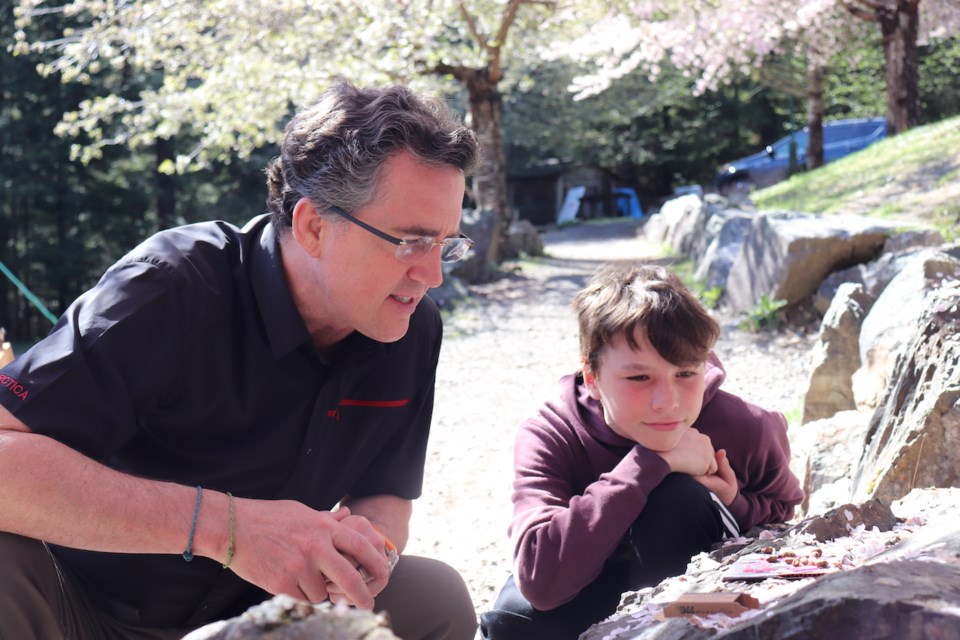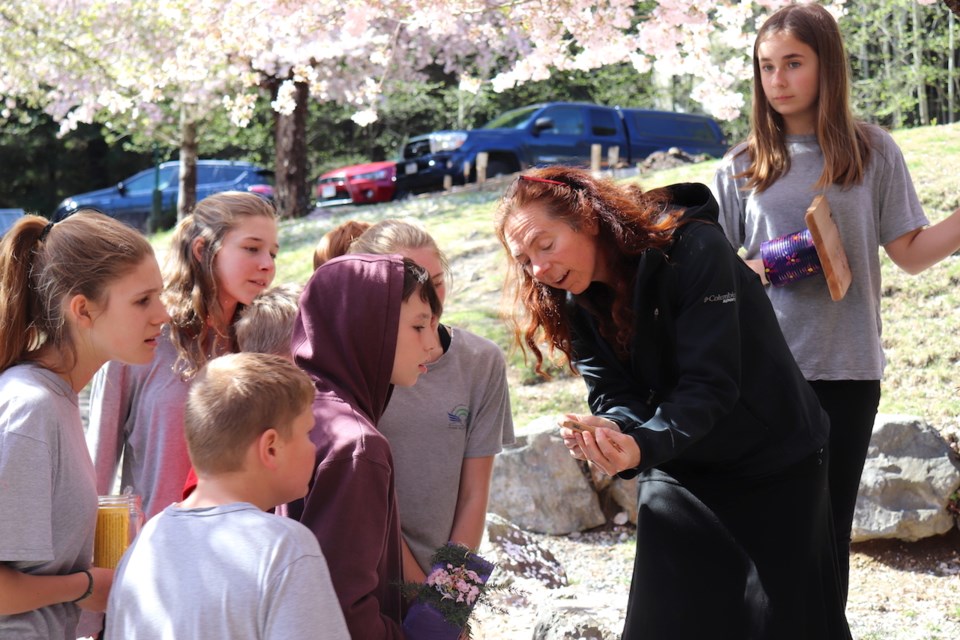Spring is a magical time of year. The birds are singing and the bees are humming. While they are beautiful to watch and they bring joy to us, they also play an important role in our lives. Imagine living in a world without flowers or fruit or even coffee or chocolate for that matter. Thanks to the wonderful work of pollinators like bees, much of the food we eat and flowers and plants we enjoy are possible.
And it’s not just bees that are doing all the work. Butterflies, birds, beetles, bats, wasps and even flies are important in the pollination process. But despite the importance of pollinators, they are taken for granted all too often. Worldwide, there is an alarming decline in pollinator populations. Excessive use of pesticides, climate change and an ever-expanding conversion of landscapes to human use are the biggest culprits.
 Island Pacific School head of school Scott Herrington and a student watch mason bees hatching. Courtesy of Pam Matthews
Island Pacific School head of school Scott Herrington and a student watch mason bees hatching. Courtesy of Pam Matthews
It is estimated that more than 1,300 types of plants are grown around the world for food, beverages, medicines, condiments, spices and even fabric. Of these, about 75 per cent are pollinated by animals. More than one of every three bites of food we eat or beverages we drink are directly because of pollinators. Indirectly, pollinators ultimately play a role in the majority of what we eat and consume.
Bowen Island has plenty of wild plants and areas to support pollinators but it is important to provide continuous corridors for pollinators. We can all do our part by making our gardens a haven for them. Here are some tips on how to create a pollinator garden:
- Choose a sunny spot that is sheltered from prevailing winds.
- Plant a diversity of blooms to attract the greatest variety of pollinators. Include a mixture of plants that will provide blooms from spring through fall. Add multiples of each plant to better catch the attention of pollinators.
- If the area you have to work with is limited, try filling a few containers with some nectar-rich flowers. Select native flowers abundant in nectar rather than exotic blooms bred for showiness.
- Satisfy the thirst of butterflies and bees on hot summer days by supplying water in a shallow dish or birdbath with half-submerged stones as perches.
- Pesticides are a butterfly’s worst enemy.
- Allow a corner of your garden to go a bit wild. Leaf litter, fallen logs or brush piles allow adult pollinators a safe place to hibernate. Leave garden cleanup until late spring to avoid destroying the pupae of butterflies and bees that overwinter on plant stems. Allow leaf litter to remain on beds wherever possible to protect species that overwinter among the leaves.
- Add some night-blooming flowers, such as evening primrose, scarlet gaura, prairie four o’clocks and phlox, to attract night-flying moths.
- And finally, you can educate yourself. If you would like to learn more about planting pollinator gardens, there are excellent resources on the web. I joined the David Suzuki foundation’s “butterfly-ways” program and committed to promoting pollinator habitats in my community. I started with Island Pacific School’s yard. Along with starting vegetables, we planted wildflower seeds in pots which will be transplanted into our pollinator garden beside the school. This garden will support our beehive as well as the wild bees that live nearby. I also obtained financial support from the Bowen Island conservancy and I have prepared seed packages which I am giving away to anyone who is interested. You can pick them up at the Bowen seed library (at the library) or send me an email and I will get them to you. If you have any questions or would like some seeds, please contact me at [email protected].
Correction: A previous version of this story identified IPS's head of school as Scott Slater. The head of school is Scott Herrington. Sorry for the mistake.



